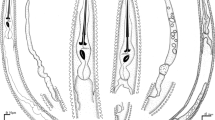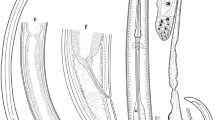Abstract
The aims of this study were to examine specimens of Contracaecum rudolphii from Australian hosts, both morphologically and genetically, based on the ITS-1 and ITS-2 sequence data, to provide a re-description for the species and to investigate the genetic make-up of this species in Australia. Morphological examination of adult specimens of C. rudolphii sensu lato Hartwich 1964 from two species of cormorants Phalacrocorax carbo and P. varius in Australia, showed that they can be divided into two distinct morphotypes. Distinction of C. rudolphii sensu lato was supported by characterisation of the ITS-1 and ITS-2 regions of rDNA which showed that they belong to two different genotypes, different from those occuring in the northern hemisphere and studied previously. Base-pair nucleotide differences of 0.9–2.2% and 1.1–6.8% for ITS-1 and ITS-2, respectively, have been detected among different genotypes of C. rudolphii sensu lato. Herein, the two new species have been designated as Contracaecum rudolphii D and Contracaecum rudolphii E.





Similar content being viewed by others
References
Abollo E, Gestal C, Pascual S (2001) Anisakid infection in the European shag Phalacrocorax aristotelis aristotelis. J Helminthol 75:209–214
Barson M, Marshall BE (2004) First record of Contracaecum spp. (Nematoda: Anisakidae) in fish-eating birds from Zimbabwe. J S Afr Vet Assoc 75:74–78
Barus V, Nagasawa K, Tenora F, Prokes M (2000) The head end morphology of Contracaecum rudolphii with remarks on C. himeu and C. umiu (Nematoda, Anisakidae). Acta Univ Agric Silvic Mendel Brun 48:69–76
Chilton NB, Gasser RB, Beveridge I (1995) Differences in a ribosomal DNA sequence of morphologically indistinguishable species within the Hypodontus macropi complex (Nematoda: Strongyloidea). Int J Parasitol 25:647–651
Cianchi R, Orecchia P, Berland B, Paggi L, D’Amelio S, Mattiucci S, Nascetti G, Bullini L (1992) Genetic studies on some Contracaecum species, parasites of fish-eating birds. In: Abstracts VIth European Multicilloquium of Parasitology, The Hague, The Netherlands, p:127
Cram EB (1927) Bird parasites of the nematode suborders Strongylata, Ascaridata, and Spirurata. Smithsonian Institution. United States National Museum. Bulletin no. 10:465 pp
D’Amelio S, Nascetti G, Mattiucci S, Cianchi R, Orecchia P, Paggi L, Berland B, Bullini L (1990) Ricerche electroforetiche su alcune specie del genere Contracaecum, parassiti di uccelli ittiofagi (Ascaridida: Anisakidae). Parassitologia 32(Supplement 1):77
D'Amelio S, Mattiucci S, Nascetti G, Orecchia P, Paggi L, Bullini L (1992) Contracaecum rudolphii S. L. in pesci ed uccelli ittogagi dei laghi del parco nazionale del circeo. Oebalia 17(supplement):569–570
D’Amelio S, Barros N, Ingrosso S, Russo R, Fauquier DA, Paggi L (2006) Molecular genotyping supports the existence of two new species of genus Contracaecum (Nematoda: Anisakidae) from fish-eating birds from Florida, USA. 11th International Congress of Parasitological Associations, 6th-11th August, Glasgow, Scotland
Freyer K (2002) Die Helminthenfauna des Einheimischen Kormorans (Phalacrocorax carbo sinensis). Institut für Parasitologie und Internationale Tiergesundheit, Fachbereich Veterinarmedizin der Freien Universitat Berlin, Berlin, Germany. 155pp
Hartwich G (1964) Revision der vogelparasitischen nematoden mitteleuropas, II. Di Gattung Contracaecum Railliet & Henry, 1912. Mitteilungen aus dei Zoologisches Museum Berlin 40:15–53
Hartwich G (1974) Keys to genera of the Ascaridoidea. In: Anderson RC, Chabaud AG, Willmott S (eds) CIH keys to the nematode parasites of vertebrates. Commonwealth Agricultural Bureaux No. 2:1-15
Kijewska A, Rokicki J, Sitko J, Wegrzyn G (2002) Ascaridoidea: a simple DNA assay for identification of 11 species infecting marine and freshwater fish, mammals, and fish-eating birds. Exp Parasitol 101:35–39
Kinsella JM, Spalding MG, Forrester DJ (2004) Parasitic helminths of the American white pelican, Pelecanus erythrorhynchos, from Florida, USA. Comparative Parasitology 71:29–36
Li A, D'Amelio S, Paggi L, He F, Gasser RB, Lun Z, Abollo E, Turchetto M, Zhu X (2005) Genetic evidence for the existence of sibling species within Contracaecum rudolphii (Hartwich, 1964) and the validity of Contracaecum septentrionale (Kreis, 1955) (Nematoda: Anisakidae). Parasitol Res 96:361–366
Mattiucci S, Turchetto M, Bragantini F, Nascetti G (2002) On the occurrence of the sibling species of Contracaecum rudolphii complex (Nematoda: Anisakidae) in cormorants (Phalacrocorax carbo sinensis) from Venice and Caorle lagoons: genetic markers and ecological studies. Parassitologia 44(Suppl.1):105
Moravec F, Nasincova V, Scholz T (1988) New records of helminth parasites from cormorants (Phalacrocorax carbo (L.)) in Czechoslovakia. Folia Parasitol 35:381–383
Mozgovoi AA (1951) The Ascaridata (Anisakoidea) of mammals in the U.S.S.R. Trudi Gelmlntologicheskoi Laboratorii. Akademii Nauk SSSR 5:14–22
Nottenkamper D, Korbel R, Kosters J (1999) Zum Befall von Kormoranen (Phalacrocorax carbo sinensis L., 1758) mit Contracaecum rudolphii (Nematoda: Ascaridoidea) im Bezirk Oberbayern (D) und Kanton St. Gallen (CH). Tierarztl Prax 27:274–279
Okulewicz A (1989) Nicienie przewodu pokarmowego u Gavia stellata i Gavia arctica (Gaviidae). Wiad Parazytol 35:35–42
Sanmartin ML, Cordeiro JA, Alvarez MF, Alvarez MF, Leiro J (2005) Helminth fauna of the yellow-legged gull Larus cachinnans in Galicia, north-west Spain. J Helminthol 79:361–371
Shamsi S, Gasser RB, Beveridge I (2008) Contracaecum pyripapillatum n. sp. (Nematoda: Anisakidae) and a description of C. multipapillatum (von Drasche, 1882) from the Australian pelican, Pelecanus conspicillatus. Parasitol Res 103:1031–1039
Shamsi S, Norman R, Gasser RB, Beveridge I (2009) Redescription and genetic characterization of selected Contracaecum spp. (Nematoda: Anisakidae) from various hosts in Australia. Parasitology Research (in Press)
Thompson JD, Gibson TJ, Plewniac F, Jeanmougin F, Higgins DG (1997) The Clustal X windows interface: flexible strategies for multiple sequence alignment aided by quality analysis tools. Nucleic Acids Res 24:4876–4882
Torres P, Sierpe V, Schlatter R (1983) Occurrence of Contracaecum rudolphii in new hosts in Chile. Zeitschrift für Parasitenkunde 69:397–399
Torres P, Ruiz E, Gesche W, Montefusco A (1991) Gastrointestinal helminths of fish-eating birds from Chiloe Island, Chile. J Wildl Dis 27:178–179
Torres P, Valdivieso J, Schlatter R, Montefusco A, Revenga J, Marin F, Lamilla J, Ramallo G (2000) Infection by Contracaecum rudolphii (Nematoda: Anisakidae) in the Neotropic cormorant Phalacrocorax brasilianus, and fishes from the estuary of the Valdivia river, Chile. Stud Neotrop Fauna Environ 35:101–108
Torres P, Ortega J, Schlatter R (2005) Nematode parasites of the digestive tract in neotropic cormorant chicks (Phalacrocorax brasilianus) from the River Cruces Ramsar site in southern Chile. Parasitol Res 97:103–107
Uchida A, Uchida K, Kawakami Y, Nagatomo M, Hong Minghao Shen Kean (2005) A helminthological survey of parasites in the waterfowl of Kanagawa Prefecture, Japan. Journal of the Japanese Veterinary Medical Association 58:127–131
Yang T, Liao X, Zeng B (2000) Population ecology of Contracaecum rudolphii in the host Gymnocypris przewalskii przewalskii in Qinghai Lake. Acta Hydrobiol Sin 24:213–218
Zuchowska E (2000) Contracaecum rudolphii Hartwich, 1964 (Nematoda: Anisakidae) u kormoranow w polsce. Wiad Parazytol 46:411–412
Acknowledgements
The authors thank Professors Lia Paggi and Hans-Peter Fagerholm for discussions. Shokoofeh Shamsi was the grateful recipient of scholarships from the University of Melbourne.
Author information
Authors and Affiliations
Corresponding author
Additional information
Nucleotide sequence data reported in this paper are available in the GenBank database under the accession numbers FM210251 to FM210273
Rights and permissions
About this article
Cite this article
Shamsi, S., Norman, R., Gasser, R. et al. Genetic and morphological evidences for the existence of sibling species within Contracaecum rudolphii (Hartwich, 1964) (Nematoda: Anisakidae) in Australia. Parasitol Res 105, 529–538 (2009). https://doi.org/10.1007/s00436-009-1424-y
Received:
Accepted:
Published:
Issue Date:
DOI: https://doi.org/10.1007/s00436-009-1424-y




